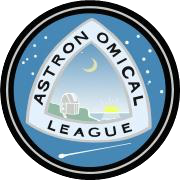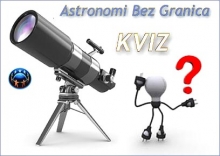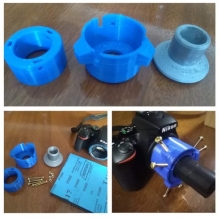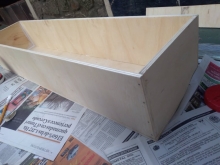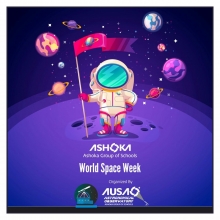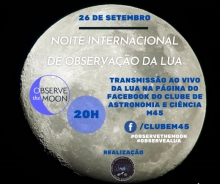For GAM2015, we will be running a series of Observing Challenges. Whether you are a complete newbie to astronomy or a seasoned veteran there will be something for you! Some of the challenges can be done in a night and some will take the whole month.
If you are a sidewalk astronomer or part of an astronomy club you might like to run events to help people complete the challenges. If are planning an Observing Challenge event, don't forget to register your event!
Discovering the Solar System
Projects for keen-eyed and camera toting observers.
Developed by John Goss of the Astronomical League
This challenge is all about observing our Solar System without any fancy equipment. We hope that be completing this challenge you will develop a new found appreciation for our sky and for naked-eye astronomy!
Share your progress on this challenge with us and the world on Facebook, the Flickr group, or Tweet using #GAM2015 hashtag (@gam_awb).
1. Solar Camera Obscura
Examine the sun by making a pin-hole camera. Punch a hole at one end of a shoe box with a small nail. Place a piece of white paper inside of the box at its other end. Face away from the sun, turn the box over, and hold it with the hole toward the sun. Look at the sun's small image projected on the paper.
If there are large sunspots, they should be discernible as small, darkened blots on the solar disk projected on the paper. (If possible, stand in a darkened room with the box held in sunlight. This should give better contrast.) Repeat this for a few days, and the sunspots will be seen to move across the solar disk, allowing an estimation of the sun’s rotational period.
Also note the uniformity of the sun’s brightness across its disk. The phenomenon of “limb darkening” should be observed.
2. Observe Mercury climb in the evening sky and change in brightness
Late April present a great time to spot little Mercury in the evening sky forty to forty-five minutes after sunset. Look for a star like object about the same distance above the western horizon as the width of your a clinched fist on your fully extend arm.
Initially, each evening Mercury climbs slightly higher. It appears to change brightness as it rises above the brightest portion of the twilight. It is also moving closer to Earth. Mercury initially sports a gibbous phase, reflecting a relatively large amount of sunlight off its cratered surface.
As it comes closer, its phase grows thinner, eventually becoming a crescent. In this portion of its orbit, it appears to move lower in the twilight toward the sun, exhibiting a slimming phase, and reflecting less light. It also moves lower, making it more difficult to spot.
Draw the horizon and plot Mercury each evening at the same time beginning April 23. Also plot where the sun is below the horizon.Begin viewing on April 23.
3. Finding Venus in the daytime sky
The third brightest object in the heavens is the cloud covered world Venus. It is so bright that it can be seen in the daytime, if one knows precisely where to look.
About 30 minutes after sunset, look towards the west for Venus shining in the twilight. Position yourself so that it is just blocked behind a building. The next day about 30 minutes before sunset, stand in that same spot (this time with the sun blocked behind the building), fully your extend arm and make a fist. Then, raise your fist so that its bottom side bumps into where Venus was the evening before. Look carefully in the sky on the top side (the eastern side) of your fist. Venus will be seen in the immediate area as a washed out “star.” Binoculars should easily spot it for confirmation.
4. Venus appears to move among the stars
As Venus swings away from the sun, it moves slightly higher each evening, passing two notable star clusters, first the Pleiades, then the Hyades. As the month begins, the Pleiades star cluster lies above Venus. The planet passes to the cluster’s left (east) from April 1 through April 10. At this time, the Hyades star cluster is to the brilliant planet’s right. Venus continues its motion, leaving the Hyades behind, climbing above. Plot Venus’ sky position with respect to the Pleiades and Hyades clusters.
5. Viewing the solar system’s largest moon without optical aid
If the sky is dark and very clear, and if the observer has keen eyesight, the solar system’s largest moon, Jupiter’s Ganymede, can be spotted with the unaided eye.
The brightness of Ganymede is approximately the same as one of the dimmer stars of the Little Dipper. If it weren’t for the overpowering glare from bright Jupiter, Ganymede could be seen in a dark sky. Position yourself so that Jupiter is barely blocked by a dark building, hiding the glaring planet. On the nights listed, with Jupiter blocked on the west side of the building, Ganymede will be glimpsed twinkling just west of the planet, about the same distance equalling 1/6 of the moon’s diameter:
April 1
April 8
April 16
April 23
and blocking Jupiter on the east side of the building, Ganymede will be east of the planet on these nights:
April 5
April 12
April 19
The April 23 sighting will likely be the easiest to spot. Jupiter’s outermost large moon, Callisto, appears very close to Ganymede, adding its light to Ganymede’s.








